| Listing 1 - 9 of 9 |
Sort by
|
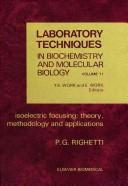
ISBN: 0444804986 9780080858807 0080858805 9780444804983 9786611756390 1281756393 0444804676 9780444804679 Year: 1983 Publisher: Amsterdam New York New York Elsevier Biomedical Press Sole distributors for the U.S.A. and Canada, Elsevier-North Holland
Abstract | Keywords | Export | Availability | Bookmark
 Loading...
Loading...Choose an application
- Reference Manager
- EndNote
- RefWorks (Direct export to RefWorks)
This book deals with theoretical and practical developments of IEF and offers detailed methodology for many of the commonly used procedures, such as IEF in gels. It is intended both as a reference guide and a practical manual.
Analytical biochemistry --- Isoelectric focusing. --- Analytical biochemistry. --- Analytic biochemistry --- Bioanalytic chemistry --- Bioanalytical chemistry --- Analytical chemistry --- Biochemistry --- Electrofocusing --- Focusing, Isoelectric --- Chemistry, Organic --- Electrophoresis --- Qualitative --- Isoelectric focusing --- 57.088.3 --- 57.08 --- 57.088.3 Methods and techniques for separation,fractionation and purification. --- Methods and techniques for separation,fractionation and purification. --- 57.08 Biological techniques. Experimental methods. Equipment --- Biological techniques. Experimental methods. Equipment
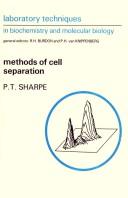
ISBN: 0444809309 0444809279 9786611716264 128171626X 0080858872 9780444809278 6611716262 9780080858876 0720442001 9780444809308 Year: 1988 Volume: 18 Publisher: Amsterdam Oxford North-Holland Pub. Co.
Abstract | Keywords | Export | Availability | Bookmark
 Loading...
Loading...Choose an application
- Reference Manager
- EndNote
- RefWorks (Direct export to RefWorks)
Methods of Cell Separation brings to the attention of researchers at all levels the variety of methods available for separating viable populations of cells. Methods are grouped into 3 categories based on the criteria of separation, namely; size or density; non-specific surface properties; and specific surface properties. The principle of each method is described together with general and, where possible, specific protocols for conducting cell separation experiments.A central theme of the book is the separation of populations of blood lymphocytes which is used as an example for e
Biological techniques --- Histology. Cytology --- Cell separation --- Cellules --- Séparation --- Cell Separation --- methods --- 57.088 --- 576.3 --- Special methods and techniques for studing biological molecules. Separation. Centrifuging. X-ray study. Radioisotope methods --- General cytology. The cell as a biological system. General plan, chemical composition, physicochemical and molecular properties --- 576.3 General cytology. The cell as a biological system. General plan, chemical composition, physicochemical and molecular properties --- 57.088 Special methods and techniques for studing biological molecules. Separation. Centrifuging. X-ray study. Radioisotope methods --- Cell separation. --- Molecular biology --- Cell isolation --- Cell segregation --- Cells --- Cytometry --- Separation (Technology) --- Technique. --- Separation --- Cell Separation - methods
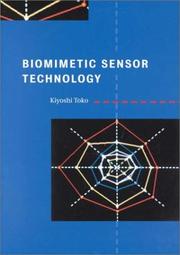
ISBN: 1107111080 0511007256 1280429313 9786610429318 0511171765 0511149077 0511309449 0511541171 1601197330 0511054424 9780511007255 9781601197337 9780511149078 9780521593427 0521593425 9780511541179 0521593425 9780521017688 0521017688 Year: 2000 Publisher: Cambridge : Cambridge University Press,
Abstract | Keywords | Export | Availability | Bookmark
 Loading...
Loading...Choose an application
- Reference Manager
- EndNote
- RefWorks (Direct export to RefWorks)
This book deals with biomimetic sensors that can quantify taste and smell - the electronic tongue and nose. Of all sensor technologies, these have been widely considered as the most difficult to realise and the development of these sensors significantly contributes to the understanding of the reception mechanisms in gustatory and olfactory systems. The author begins by dealing with the basic principles of measurement and multivariate analysis. Reception mechanisms in biological systems are briefly reviewed. Several types of biosensor, including enzyme-immobilized membranes, SPR, the quartz resonance oscillator and IC technologies are explained in detail. This book is the first to focus on artificial taste and smell sensors and also reviews conventional biosensors, such as enzyme sensors, in detail.
Biosensors. --- Chemoreceptors. --- Sensory receptors --- Chemical senses --- Biodetectors --- Biological detectors --- Biological sensors --- Biomedical detectors --- Biomedical sensors --- Detectors --- Medical instruments and apparatus --- Physiological apparatus --- Biosensors --- Chemoreceptors --- #ABIB:vcbt --- #KVIV:BB --- 543.9 --- 57.088.1 --- 664.017 --- 681.586 --- 681.586 Transducers. Sensors --- Transducers. Sensors --- 664.017 Properties of preserved foods and foodstuffs. Food quality --- Properties of preserved foods and foodstuffs. Food quality --- 57.088.1 Methods for analysis and estimation --- Methods for analysis and estimation --- 543.9 Analysis by means of biological reactions --- Analysis by means of biological reactions --- General biophysics
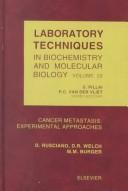
ISBN: 0720442214 1281754870 9781281754875 9786611754877 6611754873 0080858759 9780080858753 9780720442212 0720442176 9780720442175 Year: 1976 Volume: v. 6, pt. 1 Publisher: Amsterdam New York New York North-Holland Pub. Co. Sole distributors for the U.S.A. and Canada, Elsevier/North-Holland
Abstract | Keywords | Export | Availability | Bookmark
 Loading...
Loading...Choose an application
- Reference Manager
- EndNote
- RefWorks (Direct export to RefWorks)
Density Gradient Centrifugation
Biological techniques --- Immunology. Immunopathology --- Physical methods for diagnosis --- Clinical chemistry --- fysicochemie --- Radioimmunoassay. --- Analytical biochemistry --- Centrifugation, Density gradient --- Zonal centrifuge --- Centrifugation, Density Gradient --- 542.22 --- 57.088 --- 57.088 Special methods and techniques for studing biological molecules. Separation. Centrifuging. X-ray study. Radioisotope methods --- Special methods and techniques for studing biological molecules. Separation. Centrifuging. X-ray study. Radioisotope methods --- 542.22 Preparation of chemicals. Mechanical separation. Comminution. Pulverization. Elutriation. Spatulas. Spoons. Mortars, pestles. Mills --- Preparation of chemicals. Mechanical separation. Comminution. Pulverization. Elutriation. Spatulas. Spoons. Mortars, pestles. Mills --- Zonal ultracentrifuge --- Centrifuges --- Density gradient centrifugation --- Sedimentation analysis --- Separation (Technology) --- Centrifugations, Density Gradient --- Density Gradient Centrifugation --- Density Gradient Centrifugations --- Gradient Centrifugation, Density --- Gradient Centrifugations, Density --- Centrifugation, Density gradient. --- Zonal centrifuge. --- Centrifugation --- Centrifugation, density gradient. --- Density gradient. --- Centrifugation, Density Gradient. --- Radioimmunoassay --- Radioimmunoassays
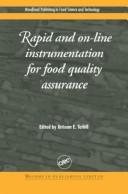
ISBN: 1855736748 9786610372935 1280372931 1855737108 9781855737105 Year: 2003 Publisher: Burlington : Elsevier Science,
Abstract | Keywords | Export | Availability | Bookmark
 Loading...
Loading...Choose an application
- Reference Manager
- EndNote
- RefWorks (Direct export to RefWorks)
Many measurements of product and process characteristics have traditionally been 'off-line', involving removing the product and taking it to a quality control laboratory for analysis over a period of hours or even days. However, the development of faster, more automated methods of production, and the shift to more proactive quality and safety management systems such as HACCP, has forced the food industry to look for more rapid methods with the potential for continuous, real-time measurement of products and processes. With its distinguished editor and international team of contributors, this im
Food adulteration and inspection. --- Food contamination --- Food industry and trade --- Food --- 57.088 --- 664.017 --- 664.019 --- 57.088 Special methods and techniques for studing biological molecules. Separation. Centrifuging. X-ray study. Radioisotope methods --- Special methods and techniques for studing biological molecules. Separation. Centrifuging. X-ray study. Radioisotope methods --- 664.019 Faults and defects of preserved foodstuffs. Food contamination. Contaminants --- Faults and defects of preserved foodstuffs. Food contamination. Contaminants --- 664.017 Properties of preserved foods and foodstuffs. Food quality --- Properties of preserved foods and foodstuffs. Food quality --- Contaminated food --- Foods, Contaminated --- Contamination (Technology) --- Food adulteration and inspection --- Analysis of food --- Food, Pure --- Food inspection --- Inspection of food --- Pure food --- Adulterations --- Consumer protection --- Public health --- Sanitary chemistry --- Foods --- Dinners and dining --- Home economics --- Table --- Cooking --- Diet --- Dietaries --- Gastronomy --- Nutrition --- Chemistry of food --- Food, Chemistry of --- Food chemistry --- Chemistry, Technical --- Measurement --- Quality control --- Analysis --- Quality&delete& --- Testing --- Contamination --- Adulteration --- Inspection --- Chemistry --- Composition --- Chemical Engineering --- Diet & Clinical Nutrition --- Health & Biological Sciences --- Chemical & Materials Engineering --- Engineering & Applied Sciences --- Quality --- Primitive societies
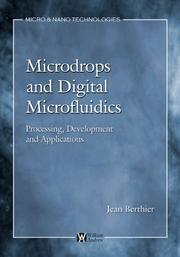
ISBN: 0815515448 9780815515449 1282169807 0815518358 0080947395 9781601195791 1601195796 9780815518341 081551834X 9780080947396 1282011251 9781282011250 9780815518358 9781282169807 Year: 2008 Publisher: Norwich, NY : William Andrew Pub.,
Abstract | Keywords | Export | Availability | Bookmark
 Loading...
Loading...Choose an application
- Reference Manager
- EndNote
- RefWorks (Direct export to RefWorks)
After spending over 12 years developing new microsystems for biotechnology û especially concerned with the microfluidic aspects of these devices û Jean Berthier is considered a leading authority in the field. Now, following the success of his book, Microfluidics for Biotechnology, Dr. Berthier returns to explain how new miniaturization techniques have dramatically expanded the area of microfluidic applications and microsystems into microdrops and digital microfluidics.Engineers interested in designing more versatile microsystems and students who seek to learn the fundamentals of micro
Atomizers --- Drops --- Electrostatic atomization --- Microdroplets --- Microelectromechanical systems --- Microfluidics --- Spraying equipment --- 532.64 --- 544.722.3 --- 57.088 --- 631.347.3 --- 66.063.5 --- 66.069.832 --- Spraying --- Agricultural implements --- Agricultural machinery --- Gardening --- Fluidics --- Nanofluids --- MEMS (Microelectromechanical systems) --- Micro-electro-mechanical systems --- Micro-machinery --- Microelectromechanical devices --- Micromachinery --- Micromachines --- Micromechanical devices --- Micromechanical systems --- Electromechanical devices --- Microtechnology --- Mechatronics --- Atomization --- Drips --- Droplets --- Liquids --- Spheroidal state --- Nebulizers --- Perfumizers --- 57.088 Special methods and techniques for studing biological molecules. Separation. Centrifuging. X-ray study. Radioisotope methods --- Special methods and techniques for studing biological molecules. Separation. Centrifuging. X-ray study. Radioisotope methods --- 532.64 Wetting angle. Contact angle --- Wetting angle. Contact angle --- 66.063.5 Wetting. Moistening. Wetting agents --- Wetting. Moistening. Wetting agents --- 631.347.3 Spraying equipment. Sprinklers. Sprays, spray-guns, jets --- Spraying equipment. Sprinklers. Sprays, spray-guns, jets --- Methodology --- Equipment and supplies --- Wettability. Chemical nature of wetting. Spreading. Spreading ability --- Atomizing. Spraying. Atomizers and spraying devices --- Equipment --- Engineering --- Mechanical Engineering --- Atomizers. --- Microelectromechanical systems. --- Equipment and supplies. --- Methodology. --- Coating processes
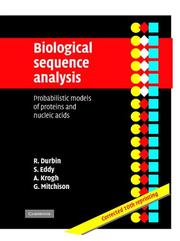
ISBN: 1107085012 1107157641 051179049X 051164471X 9786612395086 1282395084 0511648715 0511336438 051155608X 0511337086 9780511648717 9780511337086 9780511790492 9780511336430 9780521629713 0521620414 9780521620413 0521629713 Year: 1998 Publisher: Cambridge : Cambridge University Press,
Abstract | Keywords | Export | Availability | Bookmark
 Loading...
Loading...Choose an application
- Reference Manager
- EndNote
- RefWorks (Direct export to RefWorks)
Probabilistic models are becoming increasingly important in analysing the huge amount of data being produced by large-scale DNA-sequencing efforts such as the Human Genome Project. For example, hidden Markov models are used for analysing biological sequences, linguistic-grammar-based probabilistic models for identifying RNA secondary structure, and probabilistic evolutionary models for inferring phylogenies of sequences from different organisms. This book gives a unified, up-to-date and self-contained account, with a Bayesian slant, of such methods, and more generally to probabilistic methods of sequence analysis. Written by an interdisciplinary team of authors, it aims to be accessible to molecular biologists, computer scientists, and mathematicians with no formal knowledge of the other fields, and at the same time present the state-of-the-art in this new and highly important field.
Nucleotide sequence --- Amino acid sequence --- Numerical analysis. --- Probabilities. --- Probability --- Statistical inference --- Combinations --- Mathematics --- Chance --- Least squares --- Mathematical statistics --- Risk --- Mathematical analysis --- Amino acid sequence analysis --- Analysis, Amino acid sequence --- Peptide sequence --- Peptide sequencing --- Protein sequence --- Protein sequencing --- Sequence, Amino acid --- Amino acids --- Proteins --- Sequence alignment (Bioinformatics) --- Analysis, Nucleic acid sequence --- Analysis, Nucleotide sequence --- Base sequence (Nucleic acids) --- DNA sequence --- Nucleic acid sequence analysis --- Nucleotide sequence analysis --- RNA sequence --- Sequence, Nucleotide --- Nucleic acids --- Nucleotides --- Statistical methods. --- Analysis --- Numerical analysis --- Probabilities --- 57.087 --- 57.087 Methods and techniques for parameter estimation. Recording of biological data --- Methods and techniques for parameter estimation. Recording of biological data --- Statistical methods --- 57.088 --- 577.112 --- 577.113 --- #TELE:SISTA --- 577.113 Nucleic acids --- 577.112 Proteins --- 57.088 Special methods and techniques for studing biological molecules. Separation. Centrifuging. X-ray study. Radioisotope methods --- Special methods and techniques for studing biological molecules. Separation. Centrifuging. X-ray study. Radioisotope methods --- Séquence nucléotidique --- Séquence des acides aminés --- Analyse numérique --- Probabilités --- Méthodes statistiques --- Biomathematics. Biometry. Biostatistics --- Analytical biochemistry --- Nucleotide sequence - Statistical methods. --- Amino acid sequence - Statistical methods.
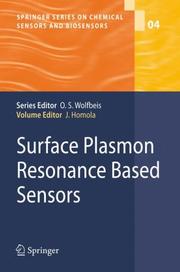
ISSN: 16127617 ISBN: 1280615508 9786610615506 3540339191 3540339183 3642070469 9783540339182 Year: 2006 Volume: 4 Publisher: Berlin New York : Springer,
Abstract | Keywords | Export | Availability | Bookmark
 Loading...
Loading...Choose an application
- Reference Manager
- EndNote
- RefWorks (Direct export to RefWorks)
Over the last two decades, surface plasmon resonance (SPR) sensors have attracted a great deal of attention. This volume of Springer Series on Chemical Sensors and Biosensors provides a comprehensive treatment of the field of SPR sensors. The book is divided into three parts. Part I introduces readers to the fundamental principles of surface plasmon resonance (bio)sensors and covers the electromagnetic theory of surface plasmons, the theory of SPR sensors and molecular interactions at sensor surfaces. Part II presents a review of the state of the art in the development of SPR sensor instrumentation and functionalization methods. Part III discusses applications of SPR biosensors for study of molecules and their interactions and detection of chemical and biological analytes related to environmental monitoring, food safety and security and medical diagnostics.
Plasmons (Physics). --- Surface plasmon resonance. --- Plasmons (Physics) --- Surface plasmon resonance --- Surface Plasmon Resonance --- Biosensing Techniques --- Chemistry Techniques, Analytical --- Investigative Techniques --- Molecular Probe Techniques --- Analytical, Diagnostic and Therapeutic Techniques and Equipment --- Atomic Physics --- Analytical Chemistry --- Chemistry --- Physics --- Physical Sciences & Mathematics --- Chemistry. --- Laboratory medicine. --- Analytical chemistry. --- Chemical engineering. --- Medical biochemistry. --- Biomedical engineering. --- Analytical Chemistry. --- Laboratory Medicine. --- Industrial Chemistry/Chemical Engineering. --- Medical Biochemistry. --- Optics, Lasers, Photonics, Optical Devices. --- Biomedical Engineering. --- Plasma oscillation quanta --- Exciton theory --- Plasma oscillations --- Plasma waves --- Quasiparticles (Physics) --- Solids --- Plasmon resonance, Surface --- Resonance, Surface plasmon --- Sensing, Surface plasmon resonance --- SPR (Surface plasmon resonance) --- Surface plasmon resonance sensing --- Biosensors --- Optical detectors --- Plasma effects --- Surface Plasmon Resonance. --- Química analítica instrumental. --- Física da máteria condensada. --- Teoria eletromagnética. --- Plasma. --- 57.088.6 --- 681.586 --- 57.088.6 Methods and techniques for studying metabolism and biotransformation.Radioisotopes methods and techniques. --- Methods and techniques for studying metabolism and biotransformation.Radioisotopes methods and techniques. --- 681.586 Transducers. Sensors --- Transducers. Sensors --- Analytical biochemistry. --- Medical laboratories. --- Biochemistry. --- Biomedical Engineering and Bioengineering. --- Clinical engineering --- Medical engineering --- Bioengineering --- Biophysics --- Engineering --- Medicine --- Biological chemistry --- Chemical composition of organisms --- Organisms --- Physiological chemistry --- Biology --- Medical sciences --- Chemistry, Industrial --- Engineering, Chemical --- Industrial chemistry --- Chemistry, Technical --- Metallurgy --- Analytic biochemistry --- Biochemistry --- Chemistry, Analytic --- Diagnosis, Laboratory --- Health facilities --- Laboratories --- Composition --- Bioanalytic chemistry --- Bioanalytical chemistry --- Analytical chemistry --- Lasers. --- Photonics. --- Light amplification by stimulated emission of radiation --- Masers, Optical --- Optical masers --- Light amplifiers --- Light sources --- Optoelectronic devices --- Nonlinear optics --- Optical parametric oscillators --- Medical biochemistry --- Pathobiochemistry --- Pathological biochemistry --- Pathology --- Clinical medicine --- Clinical pathology --- Diagnostic laboratory tests --- Laboratory diagnosis --- Laboratory medicine --- Medical laboratory diagnosis --- Diagnosis --- Analysis, Chemical --- Analytic chemistry --- Chemical analysis --- New optics --- Optics --- Chemistry, Technical. --- Clinical biochemistry. --- Biomedical Research. --- Industrial Chemistry. --- Laser. --- Research. --- Chemical technology --- Technical chemistry --- Technology --- Chemical engineering --- Biological research --- Biomedical research --- Health Workforce
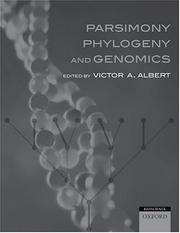
ISBN: 0198564937 0191524085 9786612335204 1282335200 1423757084 9781423757085 9780191524080 9780198564935 9780199297306 0199297304 Year: 2005 Publisher: Oxford [etc.] : Oxford University Press,
Abstract | Keywords | Export | Availability | Bookmark
 Loading...
Loading...Choose an application
- Reference Manager
- EndNote
- RefWorks (Direct export to RefWorks)
"This book examines the potential that parsimony analysis (cladistics) summarization method has for both structural and functional comparative genomic research"--Provided by publisher.
Botan. systematics, taxonomy, nomencl. --- Plant genetics. Plant evolution --- Palaeobotany --- Cladistic analysis. --- Genetics. --- Phylogeny. --- Cladistic analysis --- Genetics --- Phylogeny --- Likelihood Functions --- Genomics --- Models, Genetic --- Classification --- Probability --- Models, Statistical --- Biological Evolution --- Models, Biological --- Genetic Phenomena --- Computational Biology --- Statistics as Topic --- Information Science --- Biology --- Biological Processes --- Phenomena and Processes --- Models, Theoretical --- Biological Science Disciplines --- Epidemiologic Methods --- Investigative Techniques --- Biological Phenomena --- Health Care Evaluation Mechanisms --- Quality of Health Care --- Natural Science Disciplines --- Analytical, Diagnostic and Therapeutic Techniques and Equipment --- Public Health --- Environment and Public Health --- Disciplines and Occupations --- Health Care Quality, Access, and Evaluation --- Health Care --- Health & Biological Sciences --- Animal phylogeny --- Animals --- Phylogenetics --- Phylogeny (Zoology) --- Cladism --- Cladistic method --- Cladistic taxonomy --- Cladistics --- Cladograms --- Phylogenetic systematics --- Phylogenetic taxonomy --- Taxonomy, Cladistic --- Taxonomy, Phylogenetic --- Evolution (Biology) --- Embryology --- Mendel's law --- Adaptation (Biology) --- Breeding --- Chromosomes --- Heredity --- Mutation (Biology) --- Variation (Biology) --- Branching processes --- 575.86 --- 57.065 --- 57.088.5 --- 57.087.1 --- 57.087.1 Biometry. Statistical study and treatment of biological data --- Biometry. Statistical study and treatment of biological data --- 57.065 Phylogenetic classification systems --- Phylogenetic classification systems --- 575.86 Origin of groups of organisms (taxa). Phylogeny --- Origin of groups of organisms (taxa). Phylogeny --- Methods and techniques for studying structures and properties of biological molecules
| Listing 1 - 9 of 9 |
Sort by
|

 Search
Search Feedback
Feedback About
About Help
Help News
News